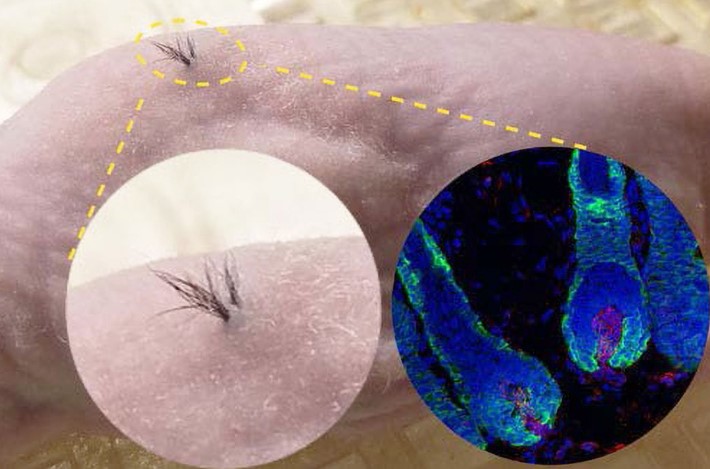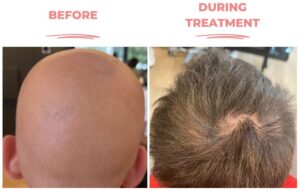Can Stemson Therapeutics Really End Hair Loss? The Truth Behind the New Hope

Imagine waking up one day, looking in the mirror, and seeing your full head of hair restored — not with pills, not with transplants, but with something far more advanced. Sounds like science fiction, right? That’s exactly what Stemson Therapeutics is working on. Their research has sparked a wave of hope in people struggling with hair loss.
But can they really deliver on their promise?
In this article, we’ll explore what Stemson Therapeutics is, how it’s different from everything else out there, and what the future might hold. Whether you're just starting to lose hair or have been searching for answers for years, this guide is here to help you understand the science, the timeline, and the possibilities.
What Is Stemson Therapeutics?
Stemson Therapeutics is a biotechnology company based in the United States. Their goal? To cure hair loss — not just cover it up.
They’re not offering shampoos, serums, or traditional hair transplants. Instead, they are developing a revolutionary method: hair cloning using your own cells.
More specifically, they are engineering induced pluripotent stem cells (iPSCs) — a type of cell that can turn into any other type of cell in the body — to become dermal papilla cells, which are responsible for creating hair follicles.
This means that instead of moving hair from one part of your head to another (like current hair transplants), they’re creating brand-new hair follicles.
Why Is Everyone Talking About Stemson Therapeutics?

Stemson’s approach is exciting because it addresses the root cause of hair loss — the death or miniaturization of hair follicles.
Here’s what makes them stand out:
- Regenerative medicine: They’re using cutting-edge stem cell tech, similar to what’s used in regenerative therapies for organs and tissues.
- Hair cloning: This means no need to "borrow" hair from other parts of your head.
- Personalized treatment: Since the cells come from your own body, the risk of rejection is low.
These are not empty promises. Stemson Therapeutics has raised millions of dollars in funding and is currently preparing for human trials.
Are Human Trials Already Happening?
Not yet — but they’re getting close.
As of now, Stemson Therapeutics human trials are expected to begin in the next 1–2 years. The company has already conducted successful preclinical studies in animals, showing that their engineered cells can grow new hair follicles.
In one experiment, they implanted lab-grown human hair follicles into mice — and hair grew.
This is a big step forward. The transition from lab results to human trials is the next milestone. Once trials begin, it will still take several years before a treatment could hit the market, assuming everything goes smoothly.
What Is Hair Cloning, Really?
Let’s break it down in simple terms.
Hair cloning is the process of taking healthy hair-producing cells from your scalp, multiplying them in a lab, and then injecting them back into your scalp to produce more hair.
Think of it like planting a single seed that grows into a whole tree. Except in this case, the seed is a dermal papilla cell, and the tree is a hair follicle.
The process that Stemson Therapeutics uses involves creating these cells from scratch using stem cells. That’s what makes it so groundbreaking.
What Makes This Better Than Transplants?
Traditional hair transplants work, but they have limitations:
- You can only transplant hair from the areas that still have it.
- If your donor area is weak, your results may be limited.
- Transplants don’t stop future hair loss.
Stemson’s approach could create an unlimited supply of hair follicles, giving people with advanced hair loss — even total baldness — the chance to regrow their hair.
That’s why many people are calling it the "holy grail" of hair restoration.
How Close Are We to a Real Treatment?
We're not there yet, but progress is being made.
Here’s a simple timeline to help you understand:
| Phase | What Happens | Estimated Time |
|---|---|---|
| Preclinical | Testing in lab and animals | Completed |
| Human Trials | Testing in people for safety and effectiveness | Expected 2025–2026 |
| Approval & Launch | Public release, depending on results | Possibly 2028–2030 |
This is a slow process, but that’s normal in medical science. It takes time to ensure treatments are safe, effective, and ethical.
What About SOT Therapy?
You may have heard of SOT therapy (Supportive Oligonucleotide Therapy), a newer approach in regenerative medicine. People often search for "SOT therapy near me" as it's being offered in some specialized clinics.
However, it’s important to note:
- SOT is not the same as what Stemson is doing.
- SOT therapy involves immune system modulation and is being tested in chronic illnesses.
- It’s not FDA-approved for hair loss.
That said, both fields are part of a bigger trend — cell-based medicine — which is shaping the future of healthcare and could eventually intersect.
Should You Wait or Try Something Now?
It depends.
If you're in the early stages of hair loss, it’s wise to start treatment now to prevent further thinning. There are effective options like:
- Minoxidil (Rogaine)
- Finasteride (Propecia)
- Low-level laser therapy
- Hair-friendly diets and protein supplements
But if you’ve tried everything and are still losing hair, it might be worth keeping an eye on Stemson Therapeutics. Sign up for their newsletter. Follow their trial updates. The future is coming — and you don’t want to miss it.
Final Thoughts: Is Stemson Therapeutics the Cure We’ve Been Waiting For?
Stemson Therapeutics is not another hype product or overnight miracle. It’s real science backed by serious investment and top researchers.
Will it cure hair loss? No one knows yet.
But it’s the closest we’ve ever been to a solution that could grow back hair — not just move it around or hide the problem.
For now, the best thing you can do is stay informed, take care of your existing hair, and get ready for what the next few years might bring.
Want to Learn More About Hair Loss Treatments?
If you're exploring other promising treatments for hair loss, check out our beginner’s guide to PP405:
👉 The Beginner’s Guide to PP405 Hair Loss Supplements


